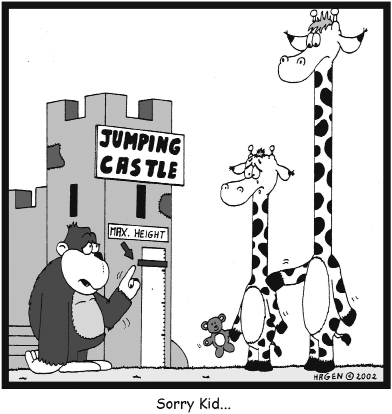Unit 8
Unit 8
Unit 8 Introduction
Consider the following statements and questions. What do they all have in common?
- “You must be over 4 feet tall to ride.”
- “How many would I have to sell to make a profit?”
- “After how many texts is cellphone plan A a better deal than plan B?”
- “How many visits to the gym make it worth buying the monthly pass over the drop-in rate?”
linear inequality: a mathematical statement that compares expressions that may not be equal using one of the following symbols:
<, >, ≤, ≥,≠
All of these statements and questions are situations that can be represented by a linear inequality. Whenever limits are set or minimums and maximums exist, a linear inequality can be used to model the situation.
In this unit you will investigate the following critical question:
- How can linear inequalities be used to solve problems?
The concepts and skills associated with linear inequalities will be presented in three lessons.

Keep up with your assignments as you go through this unit. Keep your work organized, either electronically or in a paper version. This will help you to review and reference the lessons you have learned. Reviewing may help you on tests or while you are working on a unit project. Be sure to talk to your teacher about when and how to submit your assignments.
In this unit there are a variety of assignments you will be asked to complete. Some of these include the following:
- posting to the discussion board
- adding samples of your work to your Math 9 course folder
- completing sets of questions for each lesson
- completing a unit project
- completing evaluation pieces assigned by your teacher
Strategies for Success
In order to support your success in this unit, follow these strategies.
Strategy 1
Make a foldable study tool according to the detailed instructions on page 338 of your MathLinks 9 textbook. Although this activity may not be graded for marks, you will benefit from this tool. Keep these points in mind as you develop and use this study tool.
- Add formulas, diagrams, examples, key ideas, and glossary words as you work through the lessons.
- The foldable can serve as a quick reference guide and will help you save time when you are ready to study for your unit test.
Strategy 2
In this unit you will refer to pages 336 to 373 of your textbook.
- Take time to flip through these textbook pages.
- Look at illustrations, margin features, and main titles to get a sense of where you will be going.
Strategy 3
Read your lessons and textbook materials carefully.
- Pay special attention to tables and diagrams. They have information that will help you understand what you are reading.
- Read and reread material. Take time to ensure you understand it.
- Ask yourself: What is new material to me? What do I already know?
- Move ahead with confidence.
Unit 8 Project
For the Unit 8 Project, you will create an Amusement Park Profitability Plan. You will explore and learn about ride design and capacity, tickets and pricing, park expenses, and revenue and profits. In Lessons 1, 2, and 3, you will complete the “Math Link” activities on pages 339, 349, 359, and 367.
At the completion of the unit, you will complete “Math Link: Wrap It Up!” on page 371 of the textbook. Here you will design and develop your Amusement Park Profitability Plan. For specific requirements, refer to page 371 in the textbook.

As you progress through each lesson, keep your work organized in your portfolio.
You can use the Unit 8 Project Self-Assessment Rubric to help you understand how the project will be assessed. The better you understand the characteristics of quality work, the easier it will be for you to create high-quality work. Remember, you can always discuss your project with your teacher if you have questions or if you are unclear about a requirement of the project.
Are you ready to see how inequalities can model a whole bunch of interesting situations? It starts in Lesson 1 with the tallest man who ever lived!
